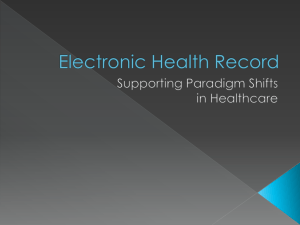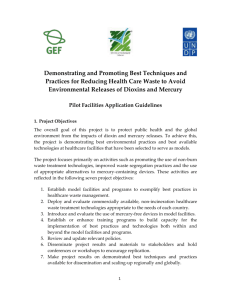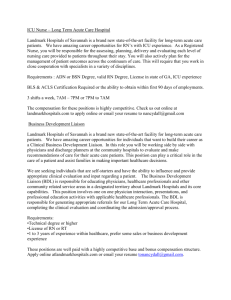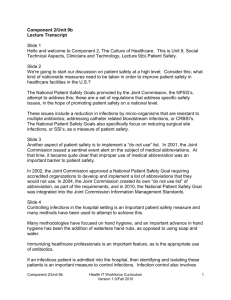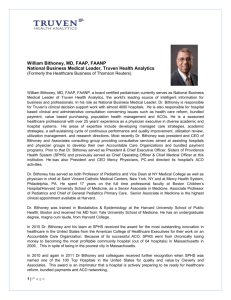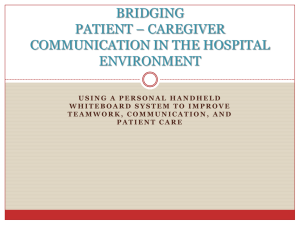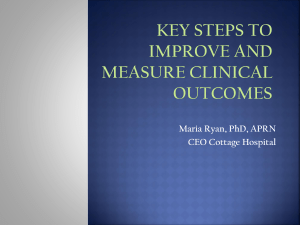Safer Systems Saving Lives - Clinical Excellence Commission
advertisement
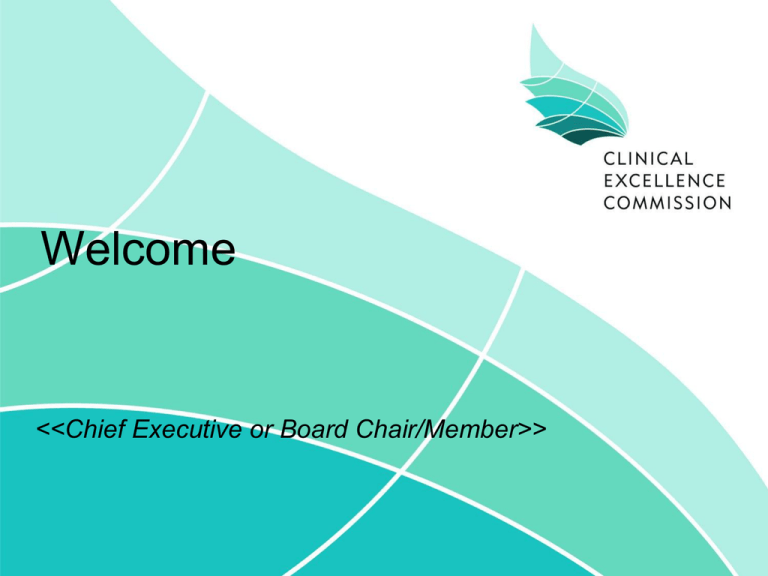
Welcome <<Chief Executive or Board Chair/Member>> From The Top – what makes leading patient based health services tick? <<Local Leader with focus on Patient Based Care>> “I couldn’t have faulted the technical care but...” Patient Based Care Model Overall Views of Health Care System, 2010 Percent AUS CAN FR GER NET H NZ NOR SWE SWIZ UK US Only minor changes needed 24 38 42 38 51 37 40 44 46 62 29 Fundamental changes needed 55 51 47 48 41 51 46 45 44 34 41 Rebuild completely 20 10 11 14 7 11 12 Source: 2010 Commonwealth Fund International Health Policy Survey in Eleven Countries. 8 8 3 27 What affects quality in health care? The level of quality in hospital environments is affected by: (1) the quality of technical care; (2) the quality of interpersonal relationships; (3) the quality of hospital amenities and the environment (Potter et. al, 1994. Int J of Health Care Qual Assur, Vol 7, pp.4–29). High performing organizations Hospitals with high levels of ‘patient care experience’ reported by patients provide clinical care that is higher in quality across a range of conditions. Jha A et al (2008) N Engl J Med 2008; 359:1921-1931. The evidence Improved patient experience is positively associated with: • Objectively measured health outcomes • Adherence to medications and treatments • Health resource usage • Technical quality of care & adverse events Doyle C et al BMJ Open Jan 20, 2013 Benefits of Patient Based Care Refocusing care delivery around the patient • Improves patient care experience.... • Improves clinical and operational-level outcomes: • improved patient adherence • fewer medication errors • decreased adverse events • improved staff satisfaction • enhanced staff recruitment • decreased length of stay • decreased ED return visits • And the bottom line. Organizational outcomes Business-case for Patient Based Care: • • • • Decreased malpractice claims Higher employee retention rates Decreased readmission rates Reduced operating costs Charmel PA, Frampton SB. Building the business case for patient-centred Care. Healthcare Financial Management 2008;March 1-6. “The three dimensions of quality should be looked at as group and not in isolation.” “Clinicians should resist sidelining patient experience as too subjective or moodorientated, divorced from the ‘real’ clinical work of measuring safety & effectiveness.” Doyle C et al BMJ Open Jan 20, 2013 Leaders in patient based care* Organisational characteristics: • Strong committed senior leadership • Communication of strategic vision • Engagement of patient and families • Sustained focus on staff satisfaction • Regular measurement and feedback reporting • Adequate resourcing of care delivery change • Staff capacity building • Accountability and incentives • Culture strongly supportive of change and learning *Luxford et.al. 2011 Int J Quality in Healthcare Vol 23(5): 510-515. Leadership commitment Start each Board meeting with a story of patient care from your service Arrange for board and executive members to visit wards to regularly talk with staff and patients Involve patient advisors in strategic planning process Demonstrate leadership commitment – communicate a patient-focussed mission to new staff at orientation Lessons learnt – Inquiries.... Mid Staffordshire, UK • Need for a common culture of ‘putting patients first’ • “Every single person serving patients needs to contribute to a safe, committed and compassionate and caring service” • Need for strong, patient centred healthcare leadership Listening to patient feedback – use to drive change.... Catheter-related bloodstream infections occur 56% more frequently in hospitals with low patient ratings for nurse or doctor communication Reed K. (2012) Health Grades Patient Safety and Satisfaction Patient feedback as a predictor... Safety: patient feedback about hospital cleanliness is a positive predictor: • for staff participation in activities like handwashing • for MRSA infection levels Raleigh V. et al (2009) – Qual. Saf. Health Care. 18: 347-354 Edgcumbe - (2008) J. Hosp. Infection What do patients value in care? Being treated with dignity and respect Having confidence & trust in providers Courtesy & availability of staff Continuity & transitions Coordination of care Pain management & physical comfort Respect for preferences Emotional support Joffe et al. (2003) J Med Ethics Jenkinson et al. (2002) Qual Saf Health Care 2.8 million patient surveys 4,610 hospitals Driver matrix – US data Red = low performance + high impact “Hospital improvement priorities do not seem to match up with what hospitals need to improve...” BHI – Insights into Care, 2009 Challenges ahead • Changing mind set of staff from ‘provider-focus’ to a ‘patient-focus’ • Change takes longer than anticipated – it’s about transforming culture and care delivered “So for whatever reason, we had the attitude where the physician is king and the patient, ‘well, we’ll get to the patient when we have time.’” (COO) *Luxford et.al. 2011 Int J Quality in Healthcare Vol 23(5): 510-515. Clinical unit level – frequency of patient involvement (CEC Quality System Assessment - NSW) Always (100%) Rarely (1% - 33%) Sometimes (34% – 66%) Not Applicable Often (67%-99%) Never (0%) Discharge planning Medication rounds / medication reconciliation Ward rounds 368 96 472 254 138 297 Shift handover 42 200 0% 196 20% 199 146 26 5 152 156 141 326 179 116 131 308 180 229 319 40% 60% 80% 100% Just streamlining processes within a clinical/provider model is not truly engaging patients Patients & their families and/or carers are viewed as integral members of the health care team 2011 – 2013 (strongly agree response) 60% 48% 50% 40% 33% 30% 28% 20% 10% 0% 2011 2012 2013 Patient engagement: Not just the ‘soft stuff’ Service quality and interpersonal relationships are critical dimensions to support and promote not only improved patient care experience but also patient safety, treatment, recovery and wellbeing (Australian Commission on Safety and Quality in Healthcare [ACSQHC], 2010). Mandatory for service accreditation from 2013 Video session
